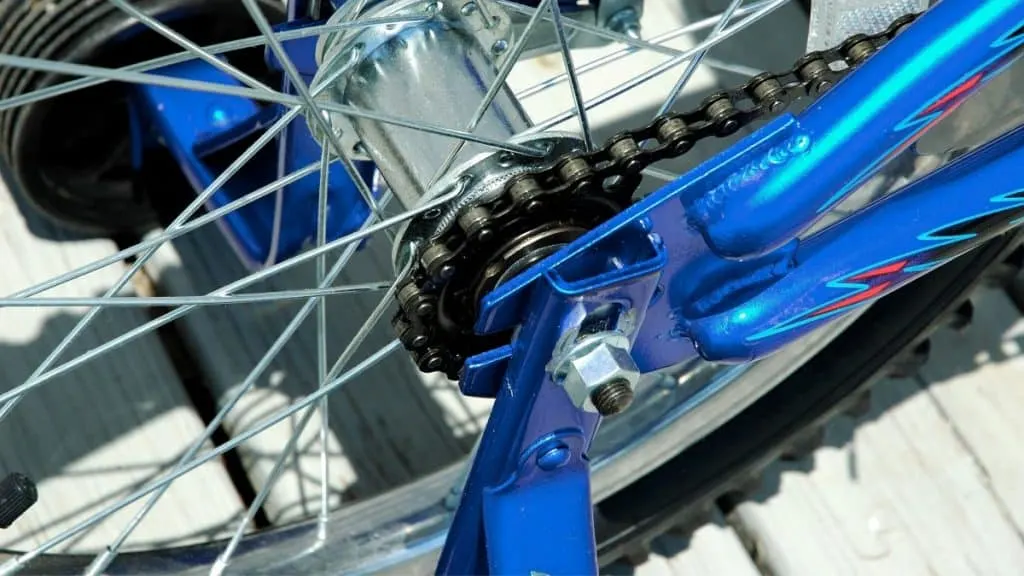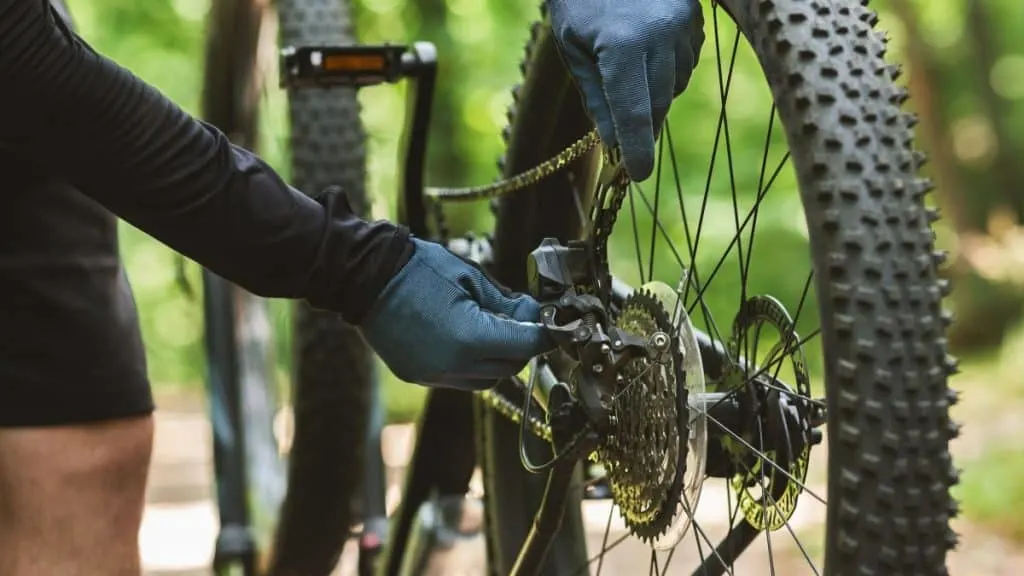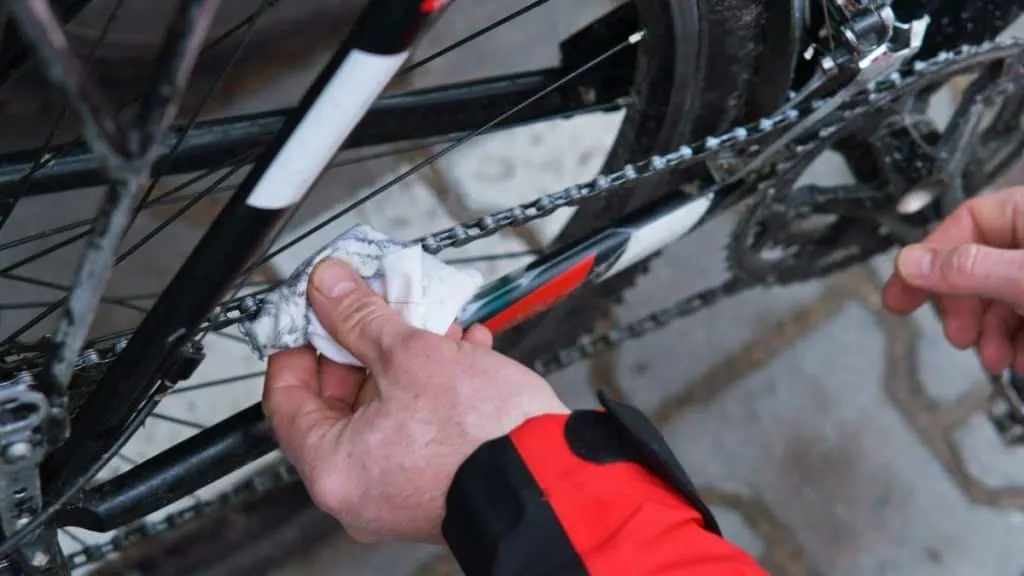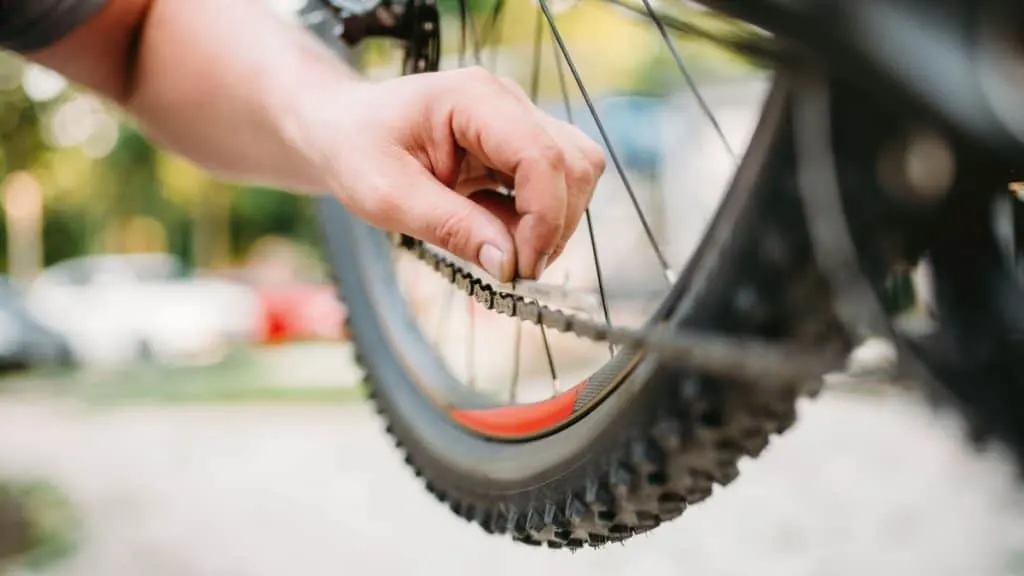
How often should you change the oil on your bike chain? This is one of those questions that will get a different answer every time it’s asked. But that’s not very helpful. What should you do about oiling your bike chain?
It is suggested that people lubricate their bike chains at least once a month. Although it is acceptable to lubricate the chain only when needed, it’s important not to leave it too long. Bike chains without lubrication build up too much friction, which can cause damage to the bikes parts.
There is no actual agreed-upon length of time before people should lubricate their bike chains, but there will definitely be damage done to your bike if it is not done when needed.
Some riders lubricate their bikes weekly, while others don’t lubricate their bike chains at all. But that’s not really good practice, as most agree that changing the oil on your bike chain is important.
This article will discuss why regular lubrication is important and will help give you an idea of how often you should be oiling your bike chain depending on your circumstances to keep your bicycle in tip top condition.
How Often You Should Change Bike Chain Oil
Bike maintenance is never clear cut because there are many factors that determine when a bike part may need cleaning or oiling.
Too little lubrication leads to friction, while too much can lead to issues with the bike’s other parts.
But there are some general rules you should follow. And knowing what to look for will help you understand when your bike chain needs oiling. Ask yourself the following questions:
- How often do you ride your bike?
- The more frequently you ride your bike, the more your chain will need to be lubricated.
- Less mileage would require less oiling and maintenance.
- What kind of weather do you typically ride in?
- If you ride (or store your bike) in wet, windy weather you’ll need to oil your chain more often.
- Bikes that have been left outside for long periods of time especially should be oiled before use.
- What kind of terrain do you typically ride in?
- If you ride in muddy, rough terrain, you’ll need to also oil your chain more.
The bottom line, is that chains exposed to rough/wet weather and/or rough terrain, and bikes used frequently benefit the most from frequent lubrication and general maintenance.
To give you and idea, if you’re riding thirty miles a week or more, a bi-weekly lubrication and maintenance would be required. But this may become weekly or even daily if you also happen to ride in wet and windy weather conditions.
If it’s only 5 miles a week (and the weather is good) then you could go for months without needing to oil your chain. So it’s a matter of using your judgement to a certain extent.
But if you’re an infrequent rider, let’s take a look at some of the signs you should look for to know that your chain needs to be lubricated…
How Do you Know When your Bike Chain Needs Oiling?
The information above should be used to give you a rough indicator of how often you should be lubricating your bicycle chain, but here are some additional signs that your bike chain needs oiling:
- the chain is particularly muddy or dirty
- you can see rust on the chain
- you can’t see oil in the cracks and crevices anymore
- the chain is making a harsh sound when riding
If you notice any of the above, it’s a definite sign that your bike chain needs to be oiled. But let’s take a look at what might happen if you neglect to oil your bike chain when it needs it…
NOTE: Check out my article “How to Stop your Bike Chain from Rusting” for further info preventing rust on your bike chain.
Why Lubricate Bike Chains?
The simple maintenance of oiling your bike chain might seem like something that can be skipped, but understanding why lubrication matters will keep your bike from falling apart.
While some of the problems are more serious than others, they can compound into more severe issues if left unattended. Let’s take a look at what can happen…
Friction, Chain Stretching, and Dirt Buildup
While there are various potential problems with bike chains, things like friction, chain stretching, and dirt buildup are not as severe but can quickly lead to more serious problems.
- Friction: Friction buildup can lead to a chain being broken. It is easy to tell when this is close to happening, however. Dry chains tend to make harsh sounds like the bike moves. In this case, lubricate your chains as soon as possible.
- Chain Stretching: One of the worst results of a lack of maintenance is stretched chains. When friction builds up between links, they can become worn and seemingly stretch. Without regular lubrication, this issue becomes common and can turn a new bike into one in need of a replaced chain very fast.
- Dirt Buildup: Between the links of your bike chain, there may be a solid buildup of dirt and other grit. Over time dirt will always accumulate, but this is especially true for frequent riders. Dirt buildup can lead to unresponsive gear shifting and other issues from your bike, and lubrication helps to keep it at bay.
Looseness and Snapping

If you end up going a long time without lubrication, two of the main problems that can occur are looseness and snapping, which can be extremely dangerous to the rider.
- Looseness: An unlubricated chain, prone to friction and stretching, is a dangerous one. If during a bike ride you notice your chain slipping from the chainring, take that as a sign that it is time for some real maintenance, maybe even replacing the chain entirely.
- Snapping: A chain that is dry and has never seen proper maintenance is one that can snap. Of course, neglecting to lubricate a chain despite being a frequent rider can do the same. A sudden snap between weak chains can lead to harmful accidents, damaging both you and the bike.
There are many reasons to lubricate your bike chains, but in the end, the best reason is your own safety. A well-maintained bike is one that can continue going beyond the norm. In fact, a properly cleaned and maintained chain can last years and up to thousands of miles.
How Do I Lubricate My Bike Chain?
Inspecting chains for a build-up of grime and dirt is the best way to know when your bike is due for a cleaning. By simply moving your bike’s pedals and keeping an eye on the chain, it is easy to see where individual links are dirty.
If the chain is dirty and it has been a while since its last lubrication, scrub your chain with a brush before lubricating it. Lubricating comes after scrubbing your chains using a chain scrubber or a rag with degreaser spray (I like this one on Amazon).
QUICK TIP: Here’s a really good bike cleaning kit on Amazon that comes with a chain scrubber as well as other useful bike cleaning bits and bobs. Its a great all rounder for bike cleaning and maintenance.
Once you’ve scrubbed your chain clean and degreased it, use your selected lube (I have this one from Amazon as it’s great for wet weather; more on the best lube to get later). As you pedal your bike backward, work the nozzle inside of the chain and apply lubricant as you go.
When you are done, it is as simple as wiping off excess lubricant with a fresh rag. Here’s a handy video showing you how it’s done:
There may be times when you notice certain links are stiff, but there is an easy fix for that. If you pedal your bike while it is stationary and spot tight, immobile links, scrubbing them of dirt clumps and lubricating the links along with the rest of the chain should be enough.
Bike Lubricant Types & Why They Matter
The point of lubricant is to keep dirt away from your chains, reduce friction, and keep your bike riding smoothly. The conditions of where you ride your bike are the most important part of determining which type of lubricant to use.
Keep in mind that not all lubricant works for bike chains, and some are better than others depending on the rider’s experience and riding conditions. There are two main types of lube. Several others lie somewhere between these two, but wet and dry lube are the main ones to know about:
- Wet Lube – Wet lubes are oil-based lubricants that are meant to resist muddy and rainy conditions. These lubricants stick closely to the chain and are hard to wash away. It is easy for dirt to build up with wet lube, so it is suggested that wet-lubed chains are regularly cleaned.
- Dry Lube – Dry lubes are highly resistant to dusty conditions. When applied, they take hours to dry, so it is suggested you plan ahead. These types of lubes are very weak to water and can easily be washed away, so they are best used for dry weather.
Other Types of Useful Bike Lube
Some lubricants fall between wet and dry, and some do not quite fall into any specific category. Some of the other lubricants are:
- Ceramic Lube – Ceramic lube can be either dry or wet. This type of lube contains trace amounts of particles to better repel dirt. This type of lube is not always reliable, with some cyclists complaining that it makes chains look dirtier.
- Aerosol Lube – Aerosol or spray lubes are not always recommended compared to their bottled counterparts, but there is still a lot to say about their performance. They are easier to apply, and they function as well as other lubes in most cases, though they can be messier when applying.
- Wax Lube – Wax-based lubes may be your best bet in dry, dusty environments. This type of lubricant rejects dirt very efficiently and could be your best bet when compared to dry lube. Wax lube, however, needs frequent reapplying after in rainy conditions.

While there are lubricants between wet and dry, they are not suggested by veteran riders. Wet and dry lubes perfectly fit the conditions they are meant to resist, so it is best to keep both handy.
No matter where you ride, it is clear that lubricant should be used if you want your chains in peak condition.
Check out my article “How to Stop your Bike Chain from Rusting” for further information on keeping your bike chain in peak condition.
The Wrong Lubricants for a Bike Chain
There are some lubricants that people believe can be used for bike chains, but oftentimes they can cause problems for your bike. (I love and regularly use the mudguard brand, available at Amazon here.)
Trusted dry and wet lube brands are always your safest bet. A few of the more common lubricants that are not advisable are:
- WD-40: WD-40 is a multi-use solvent that is not meant for the outdoors. Many amateur riders believe that it can be sprayed on their bike chain to the same effect as dry and wet lubes, which is not true. WD-40 does not last well in the elements and can quickly be washed away.
- Motor Oil: Motor oil is a thick oil that contains detergent, making it the wrong choice as a wet lube replacement. Motor oil easily gathers dust and dries into a glue-like substance, wearing down chain links.
- Vegetable Oil: Vegetable oil and other common oils found in the household can work in the short term, but it is not advisable to use them. As they are not meant for use on bikes, they do not last long at all, and some can even cause stickiness on your chain, which collects dirt.
Petroleum Jelly and Rubbing Alcohol
A few of the less commonly seen examples of “lubricant” used for bike chains are petroleum jelly and rubbing alcohol:
- Petroleum Jelly: Some riders use petroleum jelly brands to lubricate their bikes. While it works well as a lubricant, petroleum jelly can clump up and lead to tightened chains if they accumulate enough dirt. Petroleum jelly is not good at seeping between the links of the chain, which is important for any lubricant.
- Rubbing Alcohol: Rubbing alcohol is fine for cleaning the outside of bike chains, but it is not as effective as degreasers. It also does a poor job of wiping away old lubricant. While it is fine to use on other parts of your bike for simple cleaning, isopropyl alcohol is not going to do much for your chain’s longevity.
There are many issues with using any of the wrong type of lubricants listed above, but in the simplest terms, the products do not last long.
In emergencies, some can be applied. In fact, petroleum jelly could give you a solid bike ride, but future issues could come up from its use.
When to Remove your Chain for Cleaning
Sometimes lubrication and cleaning a chain while it is still attached to your bike will not be enough. If it’s particularly grimy, it is best to remove the chain entirely for a different cleaning method.
Off-bike cleaning and lubrication cannot be matched by on-bike maintenance. While the chain is off of the bike, it is also easier to inspect for damage.
Removing the chain is fairly easy with a chain tool (like this one on Amazon), but you can also use pliers to remove the master link. This link is easy to spot, connecting two sides of the chain.
Once the chain is off your bike, prepare a station either outside or indoors and lather the chain with a trusted degreasing solution. After lathering, clean it with a thin brush. Cog brushes (like this one on Amazon) are recommended the most for this job.
Once all of the dirt and grime has been removed from the chains, run it under water and dry thoroughly with an air compressor for the most efficient speed or a hairdryer.
From there, you can lubricate it as you normally would before reinstalling it on your bike. This method of maintaining your chain is recommended once every few months.
When Do I Replace a Bike Chain?
Knowing when to change out your bike chain for a new one could help extend the life of other parts of your bike. Eventually, a bike chain will wear out completely.
Frequent cyclists know this well and have probably experienced their chains failing them at the wrong time. Chain stretching, which can be avoided for a time with lubrication, is an obvious sign that something is wrong.
If you notice your chain seem longer, (though this is just an illusion caused by the chain becoming weaker), it may be time to look into a new one, especially if you are experiencing issues during your ride and after maintenance.

Another sign that your chain may be on its way out is a broken link. While this may seem obvious, a broken link can easily go unnoticed, even with regular maintenance.
If your bike is uncooperative despite frequent lubrication, remove the chain for a more thorough inspection. You may find that you have been riding with a broken chain.
How Do I Replace a Bike Chain?
Replacing a bike chain does not take an expert, but it can be hard for a beginner because there are some things to be wary of when replacing an old one. Therefore, take the time to do each step properly. Here is a breakdown:
- Remove Your Current Chain: Removing the chain can be done quickly if your bike chain has a master link. Find the two-piece link and disconnect them. If your bike lacks this, use a chain tool (Amazon link) to manually remove the pin that connects the chain to the chainring. Scrub and clean the area after.
- Clean and Lubricate Your New Chain: Though brand new chains tend to have lubrication, some cyclists prefer a thorough cleaning and rinsing of their new chain before adding it on. Treat this like simple off-bike maintenance and lubricate it properly to ensure proper safety and extended life.
- Put In Your New Chain: With your old chain off, it may not be obvious how to add the new one in. Do this through threading, where you slip the new chain through and around the derailleur cage, which is the part of the bike that holds the chain’s slack depending on which gear you are in.
QUICK TIP: Take a detailed picture of the positioning of your old chain before you take it off. This way you can easily the correct position when fitting your new chain!
A bike chain seems like a simple thing, but chains can be pretty complex. They are made up of hundreds of links, and each one working together is how a bike functions well. Knowing why a chain is important for a bike can help you better maintain it.
The primary function of a bike chain is to propel a bike forward. Made up of hundreds of links, each chain must be functioning for the best possible ride, which is why maintenance is key and why cleaning out individual links will keep the entire bike running smoothly.
Chains are crucial for one of the fundamentals of a modern bicycle, the drivetrain. A chain that is not properly cleaned and lubricated will experience drivetrain-disrupting issues. These issues can include:
- Inability to properly shift gears
- Stuck cogs
- Heavy friction due to various problems
Bike chains are perhaps the most important part of a bike. It is through dedicated maintenance that chains can last for hundreds or thousands of miles. Neglecting bike maintenance can not only be bad for the vehicle but your safety as well. Fortunately, with the right lube and a little care, you can keep your bike chain in good condition.
Check out my article “How to Keep you Bicycle Chain in Peak Condition” for further information.
